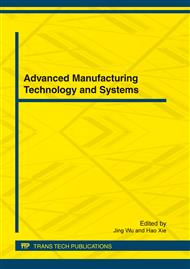p.74
p.79
p.84
p.88
p.93
p.99
p.104
p.109
p.115
Discussion on the Relation between the Adhesive Force of Drosophila Melanogaster and the Surface Roughness of the Substrate
Abstract:
Three forms of animals’ adhesion were analyzed: hairy adhesive pads, smooth adhesive pads and claw. Scanning electron microscope (SEM) was used to observe the surface of friction plate with different particle diameters. It’s found that the particle could be seen as conical shape. The self-designed lever-like testing equipment was also used to measure the adhesive force of drosophila melanogaster contacting 6 substrates with different roughness. It was shown that adhesive force decreased first and finally rose with the increase of surface roughness. When the roughness (R value) was about 68.5nm, it showed that the lowest adhesive force was 0.0085mN. Then model of the Van der Waals force was established. In this model, contact form between seta and the substrate was divided into five states, and the theoretical adhesive force at each state was calculated, which successfully simulated with the actual value. However, when surface roughness reached the situation that the gap between adjacent particles was greater than 2μm, the gripping function of the claw made the actual value greater than theoretical one. It was concluded that adhesive force was a compound function of the Van der Waals force generated by hairy adhesive force and the gripping force generated by claw. So it was also speculated that the fibrous fine pads of insects were the basic form adhesion on smooth surface of the substrate.
Info:
Periodical:
Pages:
93-98
Citation:
Online since:
March 2012
Authors:
Price:
Сopyright:
© 2012 Trans Tech Publications Ltd. All Rights Reserved
Share:
Citation:


